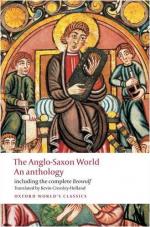
|
| Name: _________________________ | Period: ___________________ |
This test consists of 15 multiple choice questions and 5 short answer questions.
Multiple Choice Questions
1. According to the introduction of Example and Exhortation, what language did King Alfred learn to translate texts into the "vernacular" of?
(a) Druid.
(b) Latin.
(c) Celtic.
(d) French.
2. What do some believe the "Exeter Book" has been used as in the past?
(a) All of those listed.
(b) Cutting Board.
(c) Bread and cheese board.
(d) Beer mat.
3. In the stanza beginning "I'm a strange creature," what does the strange creature state it satisfies?
(a) Hunger.
(b) Cravings.
(c) Thirst.
(d) Women.
4. Whose will is the earliest surviving will of any Anglo-Saxon king?
(a) King Bede.
(b) King Hreather.
(c) King Alfred.
(d) King Solomon.
5. Where does the introduction of "I Saw a Strange Creature..." say riddles similar to the semi-metaphorical riddles of the "Exeter Book" occur?
(a) Beowulf.
(b) Chaucer's texts.
(c) Writings of the Pearl Poet.
(d) The Bible.
6. What is the name of the book that the author claims to be the earliest and most substantial work of scientific prose?
(a) Bede's "Times and Tides."
(b) "Leechdoms."
(c) "Starcraft of Early England."
(d) "Bald's Leechbook."
7. Where did the act of freeing a slave take place to "prevent subsequent violation"?
(a) In the town square.
(b) In a court.
(c) At an alter.
(d) At the lord's home.
8. Whose power does the opening line of "For a Swarm of Bees" recognize?
(a) Nature's.
(b) Man's
(c) Earth's.
(d) God's.
9. How many stress patterns does all Old English poetry contain?
(a) 7.
(b) 4.
(c) 12.
(d) 6.
10. According to "The History of the English Church and People," how does Bede describe the complexions of the slaves seen by Gregory in the Roman marketplace?
(a) Fair.
(b) Blemished.
(c) Pock-marked.
(d) Darkened.
11. What was the first use of the runic alphabet?
(a) Education of slaves.
(b) Rituals.
(c) Magic.
(d) Education of children.
12. What is the name of "one of the most popular philosophical books of the Middle Ages"? (According to the author of the introduction.)
(a) "Intermediate Teachings of Higher Thought."
(b) "Consolation of Philosophy."
(c) "Ancient Beliefs and Modern Philosophies."
(d) "Justifications of Philosophical Thought."
13. Who was the king, whose will is the earliest surviving of Anglo-Saxon history, preoccupied with threat by?
(a) Northumberlands.
(b) Swedes.
(c) Geats.
(d) Danes.
14. During the conversation between the teacher and the fowler, what do readers find out the fowler "does" to birds "in many ways"?
(a) Entices them.
(b) Fools them.
(c) Entrances them.
(d) Damages them.
15. How many times a day does the shepard milk his sheep?
(a) 2 times.
(b) 3 times.
(c) Once.
(d) Never- he doesn't own sheep.
Short Answer Questions
1. The riddles are described as being both "witty and obscene," and they are given this name?
2. Who is the first of the "Three Charms" against?
3. Where, according to the excerpt from "The History of the English Church and People," had the slaves that Gregory saw hail from?
4. At dawn what is the first thing that the ploughman does in the morning?
5. What was the name of the most powerful English king "prior to Alfred"?
|
This section contains 475 words (approx. 2 pages at 300 words per page) |

|




